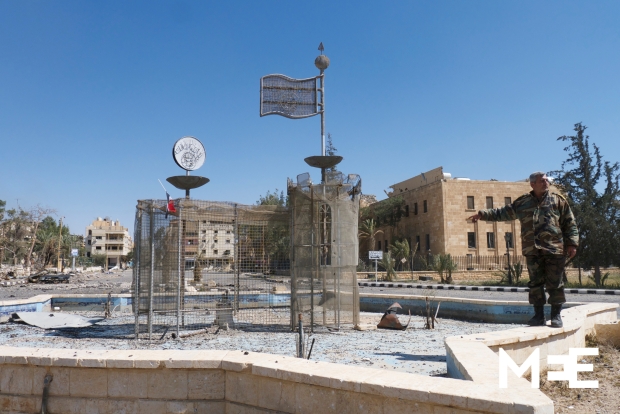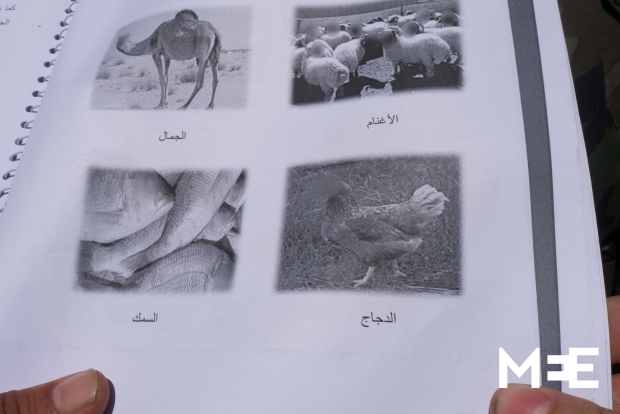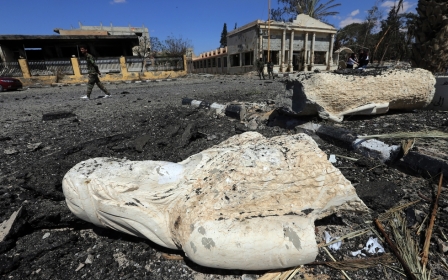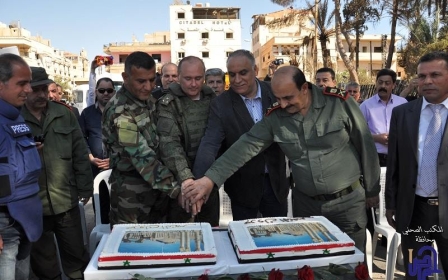Booby traps and shattered statues: Inside recaptured Palmyra
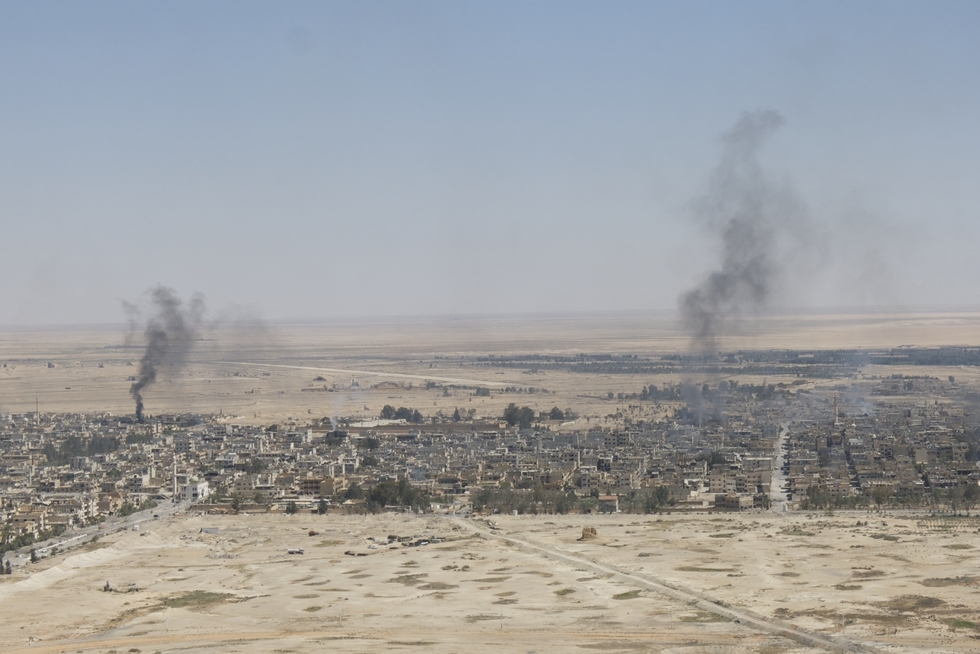
PALMYRA, Syria - “Welcome to Palmyra. May God protect you,” shouted a smiling soldier at one of the many checkpoints leading towards the town, freed last week from Islamic State (IS) control by the Syrian Arab Army (SAA).
Thin columns of black smoke were rising across the town, where Syria and Russian bomb disposal teams were deactivating and carrying out controlled explosions of mines, IEDs and booby traps left behind by IS militants.
Leaving a trail of terror, IS had rigged explosives in every conceivable place, SAA information office head General Samir Suliman told Middle East Eye.
“They put them inside dead bodies, in the trees, attached to doors - literally everywhere you can imagine, so we asked for help from Russian experts.”
More than 100 bomb disposal and de-mining experts are now working to clear the town, an operation that is expected to take several weeks to complete.
In the main square in front of the locked museum, its signage smashed and its grounds filled with shattered antiquities, stands a sinister IS remnant - a public slaughter structure. A grim metallic cage surrounding the broken pipes from the square’s former fountain is crowned with an iron IS flag and logo, below both of which are roughly hewn iron bowls.
“Daesh hung executed bodies from the top of this and let the blood drip down,” said Colonel Samir Ibrahim. “This was where the archaeologist Khaled al-Asaad was killed.”
Head of the Palmyra Antiquities Department for 40 years, 81-year-old Asaad was beheaded by IS on 18 August last year, on charges of apostasy, idolatry and working with the Syrian government. He is credited with preserving some of Palmyra’s treasures before IS reached the town, and his murder provoked international outrage.
The army still does not know how many people were executed under IS’s 10-month reign of terror, but units of the Syrian government’s volunteer National Defence Forces (NDF) have already uncovered one mass grave containing at least 40 bodies.
A displaced former Palmyra resident living in Homs said he thought the number of victims could be thousands. “They killed so many people. They killed those who stood against them, anywhere and everywhere in the town,” he said, speaking on condition of anonymity.
Wanted by IS for absconding, he still lives in terror of the militants. “They left the bodies of the dead out in the streets to go rotten. The smell was terrible. You just couldn’t imagine. I never smelled anything like that.”
Another former resident, Hassan, said he believed that most of the town’s residents, who he said numbered around 100,000 before IS seized control, had gradually managed to flee the town. It was mainly the very poorest people who had no choice but to stay, he said.
According to General Suliman, the remaining residents were instructed by IS to leave the town during last week’s battle. There are now only military personnel in the town, but residents are expected to be allowed to return in two to three weeks, after the town has been made secure.
IS takes charge
On the first day IS took control, they rounded up 40 people - mainly soldiers and government employees - and took them to Palmyra’s ancient Roman theatre. Forcing local people to watch, they beheaded the men in a public ceremony that prompted hundreds of residents to flee the town, according to the former resident now in Homs.
Within days, IS militants started targeting antiquities, smashing statues - including the Lion of Al-lat outside the town’s museum - and defacing ancient tombs. A few months later, they turned their attentions to the sprawling ruins, blowing up two important structures - the Temple of Bel and the Arch of Triumph.
“We believe that, if they could, they would have destroyed more of the antiquities, but they would have needed a huge amount of explosives and instead they used all these against the SAA.”
Despite the damage, much of the historic ruins, including the theatre and parts of a once kilometre-long colonnade of pillars lining the ancient city’s main street, remain intact. The sand-coloured columns and arches stand in stark contrast to the plumes of smoke darkening the skies above the modern town.
Amongst the ruins of the Temple of Bel, where soldiers clamber over chunks of vast ancient pillars, a few parts of structure remain standing. On one stone fragment, graffiti sprayed in red announces one of IS’s favoured mottos: “remaining and expanding”. One of the recent SAA victors has carefully written a new motto over it, in black pen: “leaving and vanishing”.
General Suliman said the Russian Air Force, which carried out multiple air strikes on Palmyra, enabled the SAA to gain control on the ground, and this had avoided any further damage to the ruins.
Another general said he was happy that some structures, including the theatre, at least, had been preserved. “This heritage has historic significance not only for the people of Palmyra but for everyone in the world,” he said.
Bricked up buildings, torn up streets
Although the ancient ruins escaped further damage during the SAA’s offensive to retake the town, the town centre of modern Palmyra has been badly damaged, both during the final week-long siege of the town and by the rigged explosives left planted by IS.
A 17-year-old NDF volunteer climbs out of a building carrying a yellow-fringed black IS flag. “Make sure you write that I’m NDF, not Daesh,” he shouts, holding it up. He tries to set fire to a section of the flag, but the fabric does not burn well.
Among the items left behind by IS are school textbooks, modified to fit in with IS ideologies. Soldiers mockingly point out how the faces of people and even animals have been blurred out, to make them suitable for the IS education the group had started in the town’s schools.
Trucks of soldiers sweeping through the town, carrying the Syrian flag, and shouting and waving show that the victory was sweet, with an estimated 450 IS militants killed in the offensive.
It was a hard-won battle. The government has always remained tight-lipped about the numbers of its dead and injured, and General Suliman described SAA losses at Palmyra as “few”. But government sources say 79 SAA forces were killed in the final week of fighting, including two generals - Shaban Oja and Amhed Hamada - who, for months, had led the ground offensive.
“I want to offer this victory to all the martyrs, but especially our two generals who were killed here by shelling from Panzer tanks,” said 23-year-old Lieutenant Ayman. He spoke from an encampment in the ancient citadel that overlooks Palmyra, the taking of which was a decisive moment in the battle for the town.
Bloodstains are still visible, dried on the ancient walls. “They were here fighting on the frontline with the soldiers during the whole of the last six months. They were very brave men. They were heroes.”
New MEE newsletter: Jerusalem Dispatch
Sign up to get the latest insights and analysis on Israel-Palestine, alongside Turkey Unpacked and other MEE newsletters
Middle East Eye delivers independent and unrivalled coverage and analysis of the Middle East, North Africa and beyond. To learn more about republishing this content and the associated fees, please fill out this form. More about MEE can be found here.


